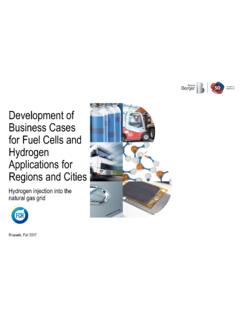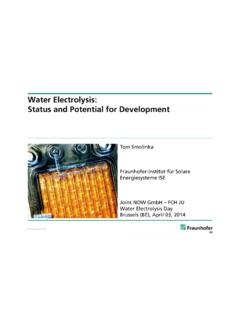Transcription of HYDROGEN ROADMAP - Europa
1 A SUSTAINABLE PATHWAY FOR THE EUROPEAN energy TRANSITIONHYDROGEN ROADMAPEUROPEThis report was prepared for the Fuel Cells and HYDROGEN 2 Joint Undertaking. Copies of this document can be downloaded from report represents the view of the industry represented by HYDROGEN Europe. It was developed with input from 17 companies and organizations: Air Liquide , BMW Group, Deutscher Wasserstoff- und Brennstoffzellenverband, Enag s, Engie, Equinor ASA, Nederlandse Gasunie, Hydrogenics, ITM Power, Michelin, NEL HYDROGEN , Plastic Omnium, Salzgitter AG, Solid Power, Total SA, Toyota Motor Europe, and information and views set out do not necessarily reflect the official opinion of the FCH 2 JU. The FCH 2 JU does not guarantee the accuracy of the data included in this study.
2 Neither the FCH 2 JU nor any person acting on the FCH 2 JU s behalf may be held responsible for the use which may be made of the information contained therein. McKinsey & Company provided analytical support. Fuel Cells and HYDROGEN 2 Joint Undertaking, 2019 Printed by Bietlot in Belgium Manuscript completed in January 2019 1st editionNeither the Fuel Cells and HYDROGEN 2 Joint Undertaking nor any person acting on behalf of the Fuel Cells and HYDROGEN 2 Joint Undertaking is responsible for the use that might be made of the following : Publications Office of the European Union, 2019 Print ISBN 978-92-9246-332-8 EG-06-18-327-EN-C PDF ISBN 978-92-9246-331-1 EG-06-18-327-EN-NReproduction is authorized provided the source is acknowledged. For any use or reproduction of photos or other material that is not under the FCH 2 JU copyright, permission must be sought directly from the copyright photographs Getty Images, Inc.
3 (title page, pages 20-21, 64-65) Sandvik Materials Technology AB (pages 48-49)FUEL CELLS AND HYDROGENJOINT UNDERTAKINGE xecutive summary .. 4 Vision: HYDROGEN is required for Europe s energy transition .. 4 Ramping up: A ROADMAP to realize HYDROGEN s potential for Europe .. 8 Acting now: Regulators, industry, and investors must launch the EU s HYDROGEN ROADMAP together ..12 Methodology ..15 The vision: Exploiting HYDROGEN s unmatched versatility to empower Europe s energy transition .. 17 Objective: Making Europe s clean energy transition efficient and economically attractive .. 18 Renewables and power: As an enabler, HYDROGEN plays a systemic role in the transformation of the energy system .. 20 Transportation: HYDROGEN and batteries will work hand in hand to electrify transport.
4 25 Buildings: HYDROGEN can decarbonize Europe s gas network .. 33 Industry heat: HYDROGEN can help industries with few alternative decarbonization options .. 37 Industry feedstock: A major decarbonization opportunity today and a long-term carbon capture enabler .. 40 Ramping up: HYDROGEN solutions are scalable and benefit Europe s economy and environment .. 44 Overview of deployment in the ambitious and business-as-usual 45 Supply perspective .. 51 Impact analysis .. 54 Acting now: Industry, investors, and policymakers must act together to realize the HYDROGEN ROADMAP in the EU .. 59 Motivation .. 60 ROADMAP .. 62 Actionable steps to start the ROADMAP .. 64 Glossary .. 66 Abbreviations .. 67 Bibliography .. 68010203 CONTENTS34 Europe s transition to a decarbonized energy system is underway.
5 The 28 Member States of the EU have signed and ratified the Conference of the Parties (COP21) Paris agreement to keep global warming well below 2 degrees Celsius above preindustrial levels, and to pursue efforts to limit the temperature increase even further to degrees Celsius. This transition will radically transform how the EU generates, distributes, stores, and consumes energy . It will require virtually carbon-free power generation, increased energy efficiency, and the deep decarbonization of transport, buildings, and industry. Stakeholders must pursue all available options to limit energy -related CO2 emissions to less than 770 megatons (Mt) per year by 2050 (see Exhibit 1).1 The recent report from the Intergovernmental Panel on 1 International energy Agency (2017) Climate Change (IPCC)2 underlines the urgency to radically lower emissions: to not exceed degrees Celsius global warming, emissions have to drop by 45% by 2030 (compared to 2010 levels) and to net zero by 2050.
6 Otherwise, major climate impact such as more extreme temperatures, rising sea levels, and significant biodiversity losses will be the report makes the case that achieving the energy transition in the EU will require HYDROGEN at large scale. Without it, the EU would miss its decarbonization objective. The fuel offers a versatile, clean, and flexible energy vector for this transition. While HYDROGEN is not the only decarbonization lever, it is an essential lever among a set of other technologies. It makes the large-scale integration of renewables possible because it enables energy players to convert and 2 IPCC (2018)VISION: HYDROGEN IS REQUIRED FOR EUROPE S energy TRANSITION EXECUTIVE SUMMARYEXECUTIVESUMMARY51 Please see the chapter on renewables and power for information on the role of HYDROGEN as enabler of a renewable power "enabled" carbon abatement from renewables is not included here and is an additional benefit of HYDROGEN for decarbonization2 Reference technology scenario, reductions in this scenario via energy efficiency, 2-degree scenario 4 Refers to scenario771508 AviationShippingRailMedium-grade heatCO2abatementpotential fromhydrogenCO2 emissionsin 2015 Low-grade heatExisting metal processingExisting chemicals(ammonia, methanol)
7 Reductionin RTS Existing refining2-3 wheelersCO2 emissionsin 2050CO2 emissionsin 2DS3in 2050 RemaininggapNew CCU (methanol, olefins, BTX)1,695 Passenger vehicles3,536 High-grade heatNew steelmaking ( , DRI)Taxis and vans1,841562 Buses and trucksClosing ~50% of gapPower generation, balancing, bufferingSegmentsHydrogen decarbonization leversCarbon emissions, MtBeyond 2DS4:254 Mt Integration of renewables into the power sector1 Power generation from renewable resources Transportation Replacement of combustion engines with FCEVs, in particular in buses and trucks, taxis and vans as well as larger passenger vehicles Decarbonization of aviation fuel through synthetic fuels based on HYDROGEN Replacement of diesel-powered trains and oil-powered ships with HYDROGEN fuel-cell-powered unitsHeating and power for buildings Decarbonization of natural gas grid through blending Upgrade of natural gas to pure HYDROGEN gridIndustry energy Replacement of natural gas for process heatIndustry feedstock Switch from blast furnace to DRI steel Replacement of natural gas as feedstock in combination with CCUO therEXHIBIT 1.
8 HYDROGEN COULD CLOSE UP TO ~50% OF THE GAP BETWEEN RTS AND 2DS1 Please see the chapter on renewables and power for information on the role of HYDROGEN as enabler of a renewable power "enabled" carbon abatement from renewables is not included here and is an additional benefit of HYDROGEN for decarbonization2 Reference technology scenario, reductions in this scenario via energy efficiency, 2-degree scenario 4 Refers to scenario771508 AviationShippingRailMedium-grade heatCO2abatementpotential fromhydrogenCO2 emissionsin 2015 Low-grade heatExisting metal processingExisting chemicals(ammonia, methanol)Reductionin RTS Existing refining2-3 wheelersCO2 emissionsin 2050CO2 emissionsin 2DS3in 2050 RemaininggapNew CCU (methanol, olefins, BTX)1,695 Passenger vehicles3,536 High-grade heatNew steelmaking ( , DRI)Taxis and vans1,841562 Buses and trucksClosing ~50% of gapPower generation, balancing, bufferingSegmentsHydrogen decarbonization leversCarbon emissions, MtBeyond 2DS4.
9 254 Mt Integration of renewables into the power sector1 Power generation from renewable resources Transportation Replacement of combustion engines with FCEVs, in particular in buses and trucks, taxis and vans as well as larger passenger vehicles Decarbonization of aviation fuel through synthetic fuels based on HYDROGEN Replacement of diesel-powered trains and oil-powered ships with HYDROGEN fuel-cell-powered unitsHeating and power for buildings Decarbonization of natural gas grid through blending Upgrade of natural gas to pure HYDROGEN gridIndustry energy Replacement of natural gas for process heatIndustry feedstock Switch from blast furnace to DRI steel Replacement of natural gas as feedstock in combination with CCUO therEXHIBIT 1: HYDROGEN COULD CLOSE UP TO ~50% OF THE GAP BETWEEN RTS AND 2 DSEXECUTIVE SUMMARY6store energy as a renewable gas.
10 It can be used for energy distribution across sectors and regions and as a buffer for renewables. It provides a way to decarbonize segments in power, transport, buildings, and industry, which would otherwise be difficult to conviction that HYDROGEN is required is based on three fundamental arguments:First, HYDROGEN is the best (or only) choice for at-scale decarbonization of selected segments in transport, industry, and buildings. Specifically: The decarbonization of the gas grid that connects Europe s industry and delivers more than 40% of heating in EU households and 15% of EU power generation requires HYDROGEN . Biogas, while an important lever, will not be available at the required scale. Electrification with heat pumps can replace natural gas to heat new buildings, but requires costly or even impossible retrofits in old buildings, which account for 90% of buildings CO2 emissions.









